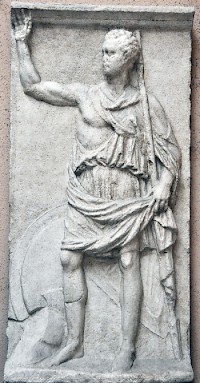Livy (4)
Titus Livius or Livy (59 BCE - 17 CE): Roman historian, author of the authorized version of the history of the Roman republic.
Sources
Livy boasted that he had read all relevant Greek and Roman books of history, and there is no reason to doubt this proud statement. On the other hand, it does not guarantee that what he writes is correct. This is not because he is a bad historian. He is deeply concerned to tell the truth and sometimes interrupts his story for remarks that betray a critical attitude:
Some writers have estimated the casualties, both our own and the enemy's, at many times the number; I myself, apart from my unwillingness to exaggerate on insufficient evidence, that all too common vice of historians, have based my account on Fabius, a contemporary witness of these events.noteThis story is more fit to be displayed on the stage, that delights in wonders, than to be believed, and is worth while neither to affirm nor to refute.note
Modern scholars complain about Livy's many topographical errors, but he is known to have traveled to Liternum (near Naples) to visit a monument that was dedicated to Publius Cornelius Scipio Africanus.note The problem is not Livy's lack of critical attitude, but the quality of his sources.
There are, essentially, two types of historians: the researcher who studies archives and writes a critical monography on a subject, and the author of a synthesis, who wants to present his readers with an entertaining narrative about a large-scale subject. It should be stressed that Livy belonged to this second category. He was a writer of history, not a researcher - or, to use the German words, a Geschichtsschreiber, not a Geschichtsforscher. He wanted to compose a history of Rome, and therefore, he had to rely upon and trust other sources. If he wanted to succeed, and there was simply no time to check the statements he found in his sources. This does not mean that he was not interested in the truth. When he noticed differences between several accounts, he informed the reader. But he was unable to solve the problem - he had to hurry.
In the nineteenth and twentieth century, when historiography became a professional occupation, Livy was severely criticized. It was maintained that he should have visited the Roman state archive and that he should have done his best to establish the truth. Modern historians, it was said, certainly would have done so. Because this criticism ignores Livy's aims and intentions, it is unfair, undeserved, and unprofessional.

Nevertheless, the question is relevant how Livy treated his sources. Fortunately, we can answer this question, because we can compare Books 21-33 of the History of Rome from its foundation with Livy's source, Books 3-18 of the World History by the Greek writer Polybius of Megalopolis (c.200-c.118). Our historian praises his predecessor as "an author by no means to be despised" and "a reliable authority on all Roman history".note He frequently uses Polybius and we can often hear verbal echoes. It seems that Livy simply retold in his own words what he had read in Polybius' World history. It is perhaps unkind to say so, but Livy's work is essentially a compilation of older sources.
We know that there were other authors. In the first pentad, he used the histories of Quintus Fabius Pictor and Lucius Calpurnius Piso Frugi. They were Rome's first historians and belonged to the Annalistic tradition, in which the subject matter was presented in the strict year-by-year order that we also find in the History of Rome from its foundation. Livy also read and used the later Annalists: the conservative and unreliable Quintus Valerius Antias, and the progressive Gaius Licinius Macer. (In the 1960s, it was claimed that Livy used only these two sources and did not really read Pictor and Piso, but this is almost certainly incorrect.)
In the second pentad, Livy could also use Quintus Claudius Quadrigarius. When he describes the war against Hannibal, Coelius Antipater and Polybius are the most important sources, but Valerius Antias is still used for the descriptions of the events in the city. In Books 31-45, Polybius, Antias and Claudius Quadrigarius were Livy's sources. All these books are lost. It is a testimony to the quality of Livy's work that almost all his sources are now lost.
Livy's account is as good as his sources, and we are fortunate that he was able to evaluate the quality of them. However, many sources for Roman history were written in Greek, a language Livy did not fully understand. Therefore, the result of this method can at times be disastrous. For example, in a description of a siege in which miners and contraminers came to blows, Polybius writes (21.28.11) that some of them carried square shields, thyreous. Livy could have retranslated this back into his own language (scuta), but confused thyreous with thyras, "doors".note The result is that he presented the Romans as carrying doors along the tunnel!
And yet, Livy is not uncritical. When he is not able to choose between variant accounts, he at least informs the reader that there are conflicting stories. It is interesting to compare his account of Hannibal's crossing of the Alps with the text of Polybius (go here for the two texts). The two descriptions ultimately go back to Sosylus of Lacedaemon, the author of seven books on Hannibal. Polybius uses this author directly, and Livy indirectly. However, he carefully copies a text that was already a careful copy. The result is better than Polybius' story. There are six points where we can compare the accounts of Polybius and Livius with the natural situation (more), and it turns out that Livy's story fits five of these, whereas Polybius' story fits only two of them. In other words, Livy knew how to choose a good source. Given his aim to write a synthesis of Roman history, this was all he needed.